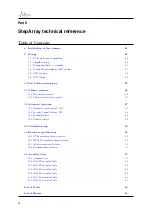
1.3
DGRC: The StepArray system
The main characteristic of an array is its
range
, which corresponds to the minimum and maximum distance (from the
column) where the SPL is constant (with a given tolerance). The range of a column is proportional to its height. An-
other important characteristic of an array is the spacing between loudspeakers. Good rejection of secondary lobes
at high frequencies is obtained with a short spacing. At high frequencies, geometric arrays generally use waveg-
uides that radiates like an isophase vertical slit. Aligning several of these waveguides yields a semi-continuous “line
source”, which greatly reduces undesired secondary lobes.
Signal
Wave
front
(a) In a geometric array, loudspeakers are aligned
along the shape of the wave front to be generated,
usually a J shape.
D 1
F 1
G 1
D 2
F 2
G 2
D 3
F 3
G 3
D 4
F 4
G 4
D 5
F 5
G 5
D 6
F 6
G 6
Signal
Wave
front
(b) In an electronic array, loudspeakers are aligned vertically, and
the wave front is synthesized by adequate filtering by filters
F
i
, de-
lays
D
i
, and gain
G
i
associated to each loudspeaker.
Figure 3: Electronic and geometric arrays
1.3
DGRC: The StepArray system
The StepArray columns implement the DGRC line-array principle (Digital and Geometric Radiation Control) which
is a synthesis of geometric and electronic arrays patented by Active Audio. The principle is illustrated in figure
The key idea is to split the desired wave-front into sections and move them back on a vertical line, much like what is
done in the Fresnel lenses used in optics. Then electronic delays are used to compensate sound propagation delay
between the sections. It was shown in [DGRC-Arrays] that with this delay setting there is no diffraction at the edges
of the saw-tooth shape. As a result of this principle, the number of DSP and amplification channels is independent
of the number of loudspeakers, so that a dramatically reduced number of channels is achieved.
8









































